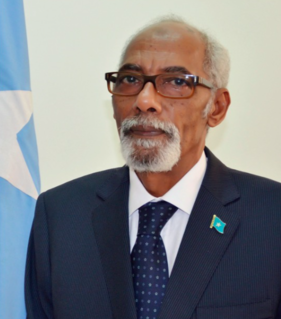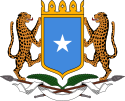
Somalia, officially the Federal Republic of Somalia and formerly known as the Somali Democratic Republic, is a country located in the Horn of Africa.
Mohamed Farrah Hassan Aidid was a Somali military commander and political leader. A former general and diplomat, he was the chairman of the United Somali Congress (USC) and later led the Somali National Alliance (SNA). Along with other armed opposition groups, they drove out President Mohamed Siad Barre's socialist regime from Somalia's capital Mogadishu during the Somali Civil War that broke out in the early 1990s.

Ali Mahdi Muhammad is a Somali entrepreneur and politician. He served as President of Somalia from January 26, 1991 to January 3, 1997.

The Hawiye is a Somali clan. Members of the clan traditionally inhabit central and southern Somalia, Ogaden and the North Eastern Province. Like many Somalis, Hawiye members trace their paternal ancestry to Irir, one of the sons of Samaale.
Hussein Mohamed Farrah Aidid is the son of General Mohamed Farrah Aidid. His father was leader of the Somali National Alliance (SNA), the organization that fought US forces in Mogadishu, and became the President of Somalia on June 15, 1995, through his death on August 2, 1996, after being shot in a battle. Farrah succeeded his father as leader of the SNA, and two days after his father's death, the SNA declared Farrah as the new President, although he too was not internationally recognized as such. Farrah relinquished his claim as president in December 1997, by signing the Cairo Declaration, a significant step toward peace in Somalia.
The United Somali Congress (USC) was one of the major rebel organizations in Somalia. Formed in 1987, it played a key role in the ouster of the government of Siad Barre in 1991, and became a target of the Unified Task Force campaign in 1993. Following infighting, the USC later splintered into smaller groups. By 2004, with the establishment of a Transitional National Government (TNG), a process of disarmament was put in motion and some moderate ex-USC leaders were incorporated into the new interim administration.
The Dir is a major Somali clan. Its members inhabit Djibouti, northwestern Somalia, Ethiopia, and northeastern Kenya.

The Transitional Federal Government (TFG) was the internationally recognized government of the Republic of Somalia until 20 August 2012, when its tenure officially ended and the Federal Government of Somalia was inaugurated. The TFG was established as one of the Transitional Federal Institutions (TFIs) of government as defined in the Transitional Federal Charter (TFC) adopted in November 2004 by the Transitional Federal Parliament (TFP).

The Transitional National Government (TNG) was the internationally recognized central government of Somalia from 2000 to 2004.

The transitional federal government (TFG) was the government of Somalia between 2004 and 2012. Established 2004 in Djabuti through various international conferences, it was an attempt to restore national institutions to the country after the 1991 collapse of the Siad Barre government and the ensuing Somali Civil War.
Many factions opposed to Siad Barre set aside tribal and political differences to unite in purpose to overthrow his regime. After the collapse of Siad Barre's government in 1991 the nation fell into a long period of increasingly chaotic conflict between forces of clans, militias, warlords, separatist, religious functions and rebellion movements, other nations, and even the United Nations Peace Keepers.
Over the course of the Somali Civil War, there have been many revolutionary movements and militia groups run by competing rebel leaders which have held de facto control over vast areas of the country.

The Federal Government of Somalia (FGS) is the internationally recognised government of Somalia, and the first attempt to create a central government in Somalia since the collapse of the Somali Democratic Republic. It replaced the Transitional Federal Government of Somalia on 20 August 2012 with the adoption of the Constitution of Somalia.

The Federal Parliament of Somalia is the national parliament of Somalia. Formed in August 2012, it is based in the capital Mogadishu and is bicameral, consisting of an Upper House (Senate) and a Lower House. The tenth Parliament of Somalia was inaugurated on 27 December 2016.

Mohamed Osman Jawari, also known as Mohamed Jawari or Osman Jawari, is a Somali attorney and politician. He is former Speaker of the Federal Parliament of Somalia. He also briefly served as acting President of Somalia in August and September 2012.

The Interim Government of Somalia, led by Ali Mahdi Muhammad, was established immediately after the collapse of the Somali Democratic Republic. From November 1991 to 1995, Ali Mahdi Muhammad enjoyed recognition as President in the international community following the 1991 Djibouti conference held between 15 and 21 July 1991, Ali Mahdi was elected interim President of Somalia for a period of two years, but because of the legitimacy conferred on Ali Mahdi by the Djibouti conference, his government was recognized by several countries, including Djibouti, Egypt, Italy, and Saudi Arabia.






















